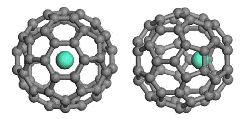Chemistry, Department of: Faculty Series

Xiao Cheng Zeng Publications
Document Type
Article
Date of this Version
1-25-2005
Citation
PNAS, January 25, 2005, vol. 102, no. 4, pp. 961–964.
Abstract
Experimental and computational simulations revealed that boron clusters, which favor planar (2D) structures up to 18 atoms, prefer 3D structures beginning at 20 atoms. Using global optimization methods, we found that the B20 neutral cluster has a double-ring tubular structure with a diameter of 5.2 Å. For the B20- anion, the tubular structure is shown to be isoenergetic to 2D structures, which were observed and confirmed by photoelectron spectroscopy. The 2D-to-3D structural transition observed at B20, reminiscent of the ring-to-fullerene transition at C20 in carbon clusters, suggests it may be considered as the embryo of the thinnest single-walled boron nanotubes.


Comments
U. S. government work.